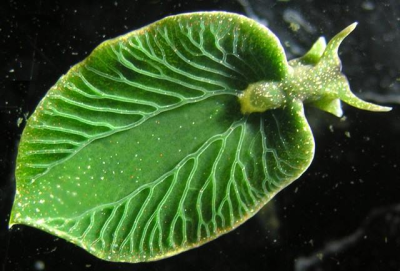Elysia chlorotica, the slug that behave like a leaf
PDFElysia chlorotica, a sea slug able of drawing its energy from photosynthesis!
The sea slug called Elysia chlorotica is a small 5 cm-long marine gastropod. It lives in shallow waters along the east coast of North America. This strange slug looks like a leaf. It’s green! When the sun shines, it spreads out, as if to enjoy the sun. How is that possible? Elysia chlorotica feeds on filamentous algae such as Vaucheria littorea. During digestion, the photosynthetic cells from the algae are only partially destroyed: their chloroplasts remain intact and allow Elysia to use the products of photosynthesis to feed itself. This is an example of chloroplastic symbiosis or kleptoplasty [1], in other words, chloroplast robbery. These chloroplasts contain chlorophyll, a pigment that captures light during photosynthesis and gives the sea slug its green colour. They are present in the cells of his highly branched digestive tract. That’s why Elysia chlorotica looks like a green leaf, presenting leaf vein-like structures. This property seems to be specific of this family, since several related species have the same behaviour.

But for the sea slug Elysia chlorotica, things are very different. The mollusc has acquired chloroplasts during its development, i.e. during the transition from larval to adult form. Chloroplasts then remain functional throughout the life of the sea slug. Thus, Elysia chlorotica seems to feed on algae only at the beginning of its existence, then it is drawing its energy exclusively from photosynthesis. Experiments have shown that in the presence of light and CO2, Elysia chlorotica is able to incorporate CO2 into its organic matter through photosynthesis. However, the fact that the presence of chloroplasts is essential to the life of sea slugs remains controversial.
In plants, the chloroplast needs the permanent import of proteins synthsized in the cytoplasm. The fact that the chloroplasts sequestered in the sea slug’s digestive system are able to carry out photosynthesis for months is therefore somewhat problematic. Sequencing of the host genomes – the slug – and the symbiont – the algae – showed that genes essential for photosynthesis had been acquired by the animal by horizontal gene transfer from the nucleus of the algae. The proteins thus encoded are then redirected to the plastid [2]. Thus, in the case of this sea slug, predation – i.e. the consumption of a green algae – has been accompanied by a horizontal gene transfer between the symbiont nucleus and that of the host. This system is at the origin of a metabolic novelty, “green animals”, that are able of performing photosynthesis for several months, thanks to chloroplasts remaining functional in the host tissues [1].
To go further: Elysia chlorotica in action
A lecture on Elysia by Dr. Sidney Pierce at TEDx Tampa Bay (Florida, USA)
References and notes
[1] Rumpho M.E., Dastoor F.P., Manhart J.R. & Lee J. (2006) The Kleptoplast. In: Advances in Photosynthesis and Respiration – The Structure and Function of Plastids. R.R. Wise & J.K. Hoober, eds, Springer Pub., Vol. 23, pp 451-473
[2] Rumpho M.E., Worful J.M., Lee J., Kannan K., Tyler M.S., Bhattacharya D., Moustafa A. & Manhart J.R. (2008) Horizontal gene transfer of the algal nuclear gene psbO to the photosynthetic sea slug Elysia chlorotica. PNAS USA 105, 17867-17871
Further readings
- Dabonneville C. (2013) Les animaux-plantes ou comment un animal peut-il être photosynthétique ? Espèces 9, 22-29. (in french)
- Biofutur (2009) special issue on “Endosymbioses”, n°299 (in french)
绿叶海蛞蝓,像一片绿叶的蛞蝓
PDF绿叶海蛞蝓(Elysia chlorotica),一种能够从光合作用中汲取能量的海蛞蝓!
这种海蛞蝓被称为绿叶海蛞蝓(Elysia chlorotica),是一种体长5厘米的小型海洋腹足类动物。它生活在北美东海岸的浅水区。这种奇怪的蛞蝓看起来像一片树叶。是绿色的!当阳光照耀时,它就会散开,仿佛在享受阳光。这怎么可能?绿叶海蛞蝓以丝状藻类为食,如滨海无隔藻(Vaucheria littorea)。在消化过程中,藻类的光合作用细胞只有部分被破坏:它们的叶绿体保持完整,使蛞蝓能够利用光合作用的产物来养活自己。这是叶绿体共生或盗食质体(换句话说,也就是窃取叶绿体)一个例子 [1]。这些叶绿体含有叶绿素(叶绿素是一种在光合作用中捕捉光的色素),因此海蛞蝓呈现绿色。这些色素广泛存在于蛞蝓高度分化的消化系统内。这就是为什么绿叶海蛞蝓看起来像一片绿叶,呈现叶脉状结构。这种特性似乎是这个科特有的,因为其他几个近缘物种也有相似的行为。

一般来说,许多海洋生物保留从猎物身上吸收的叶绿体:绿藻、红藻或褐藻。然后,他们将这些叶绿体整合到自己的消化系统中,并利用它们为自己服务。吸收来的叶绿体的寿命通常是有限的,但持续不断的捕食可以维持叶绿体的更新。光合生物共生过程存在一种最为稳定的关系:例如珊瑚,由珊瑚虫(也称水螅)分泌的石灰质骨骼聚结而成(参阅 珊瑚:濒危的海洋工程师)。这种组织含有许多虫黄藻,即共生属(Symbiodinium)的一种光合微藻。
对于绿叶海蛞蝓来说,情况明显不同。这种软体动物是在其发育过程(即从幼虫向成虫的转变过程中)中获得了叶绿体,随后在其整个生命周期中,所获得的叶绿体都保持着功能。因此,绿叶海蛞蝓似乎只需在其生命早期捕食藻类,之后就可以依靠光合作用维持生命活动。实验表明,在光和二氧化碳存在的情况下,绿叶海蛞蝓能够通过光合作用将二氧化碳融入其自身有机物中。然而,叶绿体的存在对海蛞蝓的生存至关重要这一事实,仍有争议。
在植物中,叶绿体要想保持功能,需要持续输入细胞质合成蛋白。因此,保留在海蛞蝓消化系统中的叶绿体能够进行数月的光合作用,这一论断显然是有些问题的。对宿主(蛞蝓)和共生体(藻类)的基因组测序表明,蛞蝓光合作用所必需的基因是从藻类细胞核水平转移而来的。随后,其编码产物(蛋白质)被重新转移到质体(即叶绿体)中 [2]。因此,以这种海蛞蝓为例,捕食——即绿藻的消耗——伴随着共生细胞核和宿主细胞核之间的水平基因转移。该系统是一种全新代谢方式的起源,即“绿色动物”,由于叶绿体在宿主组织中保持功能,这种动物能够进行数月的光合作用 [1]。
了解更多:鲜活的海蛞蝓
在TEDx坦帕湾(TEDx Tampa Bay)(美国佛罗里达州),由西德尼·皮尔斯博士(Dr. Sidney Pierce)开展的关于海蛞蝓的讲座。
参考资料和说明
[1] Rumpho M.E., Dastoor F.P., Manhart J.R. & Lee J. (2006) The Kleptoplast. In: Advances in Photosynthesis and Respiration – The Structure and Function of Plastids. R.R. Wise & J.K. Hoober, eds, Springer Pub., Vol. 23, pp 451-473
[2] Rumpho M.E., Worful J.M., Lee J., Kannan K., Tyler M.S., Bhattacharya D., Moustafa A. & Manhart J.R. (2008) Horizontal gene transfer of the algal nuclear gene psbO to the photosynthetic sea slug Elysia chlorotica. PNAS USA 105, 17867-17871
延伸阅读
- Dabonneville C. (2013) Les animaux-plantes ou comment un animal peut-il être photosynthétique ? Espèces 9, 22-29. (in french)
- Biofutur (2009) special issue on “Endosymbioses”, n°299 (in french)
译者:刘鑫 编审:袁军涛 责任编辑:胡玉娇




